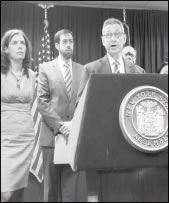BY Aline Reynolds
Residents near Ground Zero fear the worst as they anticipate heightened congestion when the National September 11th Memorial and Museum opens in September.
Approximately 1,500 people an hour are expected to visit the memorial, 20 percent of whom are likely to arrive at the site by tour bus, according to New York State Assembly Speaker Sheldon Silver.
Silver, along with other local elected officials, met with members of Community Boards 1 and 3, the New York City Department of Transportation and the New York Police Department last Friday, April 15, to discuss new parking regulations, enforcement for the tour buses and alternative means of transportation for World Trade Center visitors.
The memorial, which is expected to draw five to seven million people annually, will receive between six and eight busloads of visitors per hour. The resulting traffic congestion and air pollution could pose everyday hassles and safety risks for local residents if not properly dealt with, according to New York State Assemblywoman Deborah Glick. “We want to ensure that this very, very significant increase in our daily visitors is handled in a way that’s good for people who live here,” she said.
“The goal here is to have as many visitors in Lower Manhattan as we can handle… without new tour buses,” said State Senator Daniel Squadron, adding that the City “needs to be ahead of the curve” in planning.
The senator, along with C.B. 1 Chair Julie Menin, stressed the importance of encouraging alternative transportation methods to the W.T.C. Rather than clutter the streets and increase air pollution around Ground Zero, the tour buses, Menin advised, should park across the river in New Jersey, and visitors should use the Port Authority Trans-Hudson (PATH) train to get to the memorial.
The D.O.T., NYC and Company (the City’s tourism arm) and the Downtown Alliance, plan to offer incentive packages for tour buses to encourage remote parking. The memorial, meanwhile, intends to partner with bus companies and ferry operators to promote tourists’ use of mass transit.
Public transportation use, the stakeholders said, could also help nurture Downtown’s economy, since visitors traveling via subway or ferry would be more likely to explore the neighborhood before or after their visit to the memorial.
“We don’t just want them to come into the memorial, leave, and go back to wherever they came from,” said Silver. “We want them in the restaurants and the shops… and to spend some money in Lower Manhattan.”
To address the tour buses that will be shuttling visitors to Downtown, the stakeholders agreed on establishing a permit system and designating specific drop-off and pick-up sites in the neighborhood. The D.O.T. will be implementing the city’s first metered parking program with maximum time limits for the buses, and is collaborating with the 9/11 memorial to devise a timed reservation system for its visitors.
Luis Sanchez, the D.O.T.’s Lower Manhattan Borough Commissioner, said the Department is considering Trinity Place and Church Street as drop-off and pick-up locations for buses during off-peak hours and Barclay and West Streets as layover and parking places.
The stakeholders also asked that 100 percent of the revenue derived from the tour buses finance traffic regulation enforcement and the upkeep of the memorial park.
“We’re opening on the memorial a park that is larger than Bryant Park; we need to make sure it is maintained for the five million people who are going to come into our community,” said Menin.
The N.Y.P.D. indicated at the stakeholders meeting that it would be enforcing the new parking laws, though finances for the added services have yet to be identified. Squadron said he hopes the stakeholders will locate some funding sources by their next monthly meeting on May 19.
“The process is far from finished, but we’re certainly off to a positive start,” said Silver. “We’ve established a basis for future discussions on how to develop and implement an effective plan that limits the number of buses that arrive in Lower Manhattan.”
Nearby residents, however, are skeptical that the city will be able to mitigate the negative impact of the large influx of tourists.
“It’s just going to be a bigger nightmare than ever,” said Esther Regelson, who has lived two blocks south of the W.T.C. site, on Washington St. for nearly three decades. “We really have become a dumping ground for [traffic and tourists.]”
Regelson, a biker, said she is fed up with the number of streets near the W.T.C. that are blocked off for construction, and with the amount of dust in her apartment.
“I don’t think these streets are equipped to handle [tour buses],” she said. “We have to encourage alternate means of transportation, and discourage any vehicles larger than a taxi coming through.”
Jason Perkal, who lives on Greenwich St., is concerned about both the bus and pedestrian traffic the memorial’s opening will bring to the area.
“I’m not looking forward to seeing huge buses getting stuck on my street just because they can’t make the turns properly, and then standing and idling all over,” he said. Perkal also fears noise pollution from the buses and envisions having to squeeze through large crowds congregating on the streets on a daily basis.
“It’s all not pleasing,” he said. “It’s a residential neighborhood and we’re trying to keep it that way.”
































